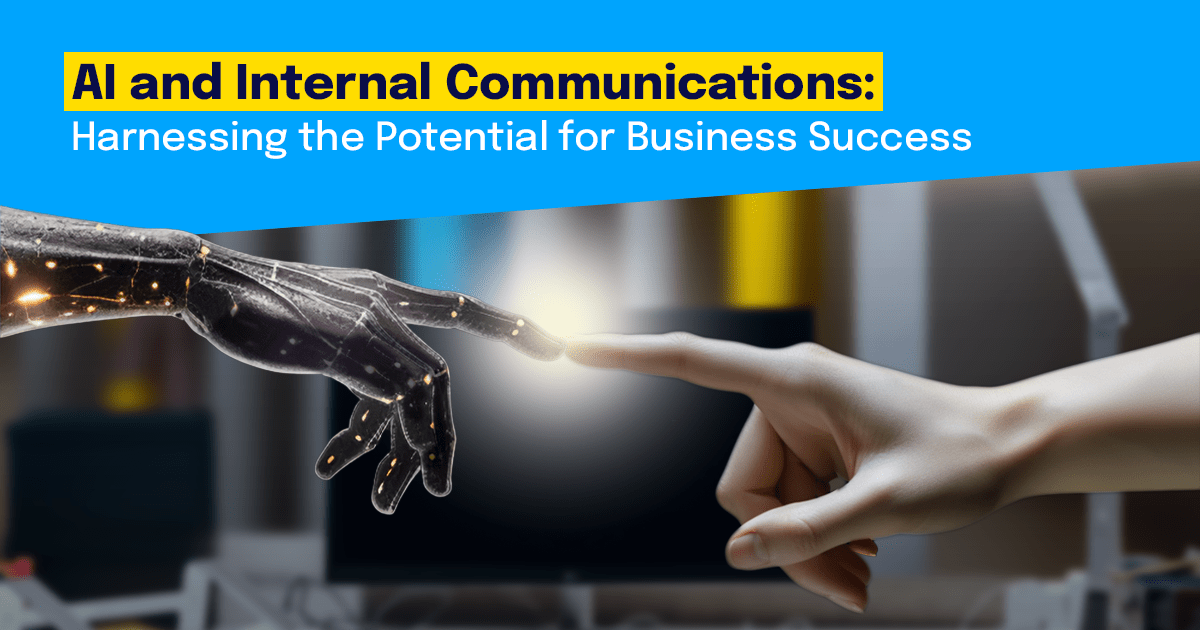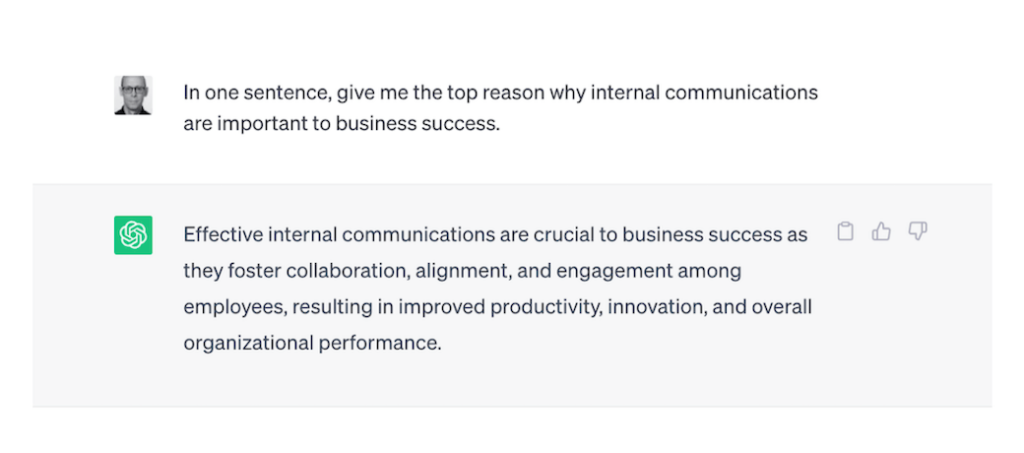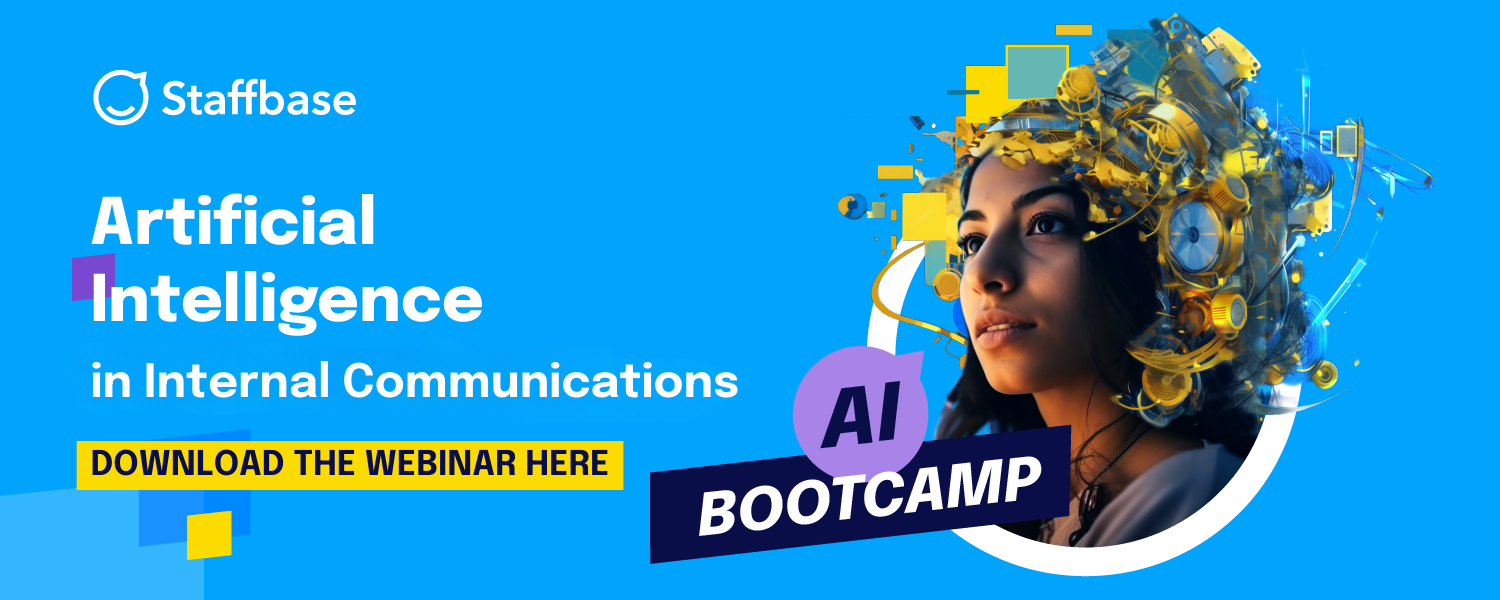AI for Internal Communications: Harnessing the Potential for Business Success
The AI revolution is changing everything, including internal comms. Here's how communicators can use AI to strengthen and secure their important role while fulfilling their company’s strategic goals.

As an internal communications professional, it’s no doubt you’ve been hearing a lot about artificial intelligence (or AI) in internal comms. Depending on who you ask, it’s either going to make your job a whole lot easier — or it’s going to steal it from you. As the eyes and ears of your organization, it’s also likely you’ve noticed that the topic of AI has been on the minds of your people, who surely have similar concerns.
So, should AI be causing you relief or worry? The honest answer is probably a little bit of both. As Staffbase CSO and co-founder Frank Wolf recently remarked at VOICES 2023, “You’re not likely to lose your job to AI, at least not yet. But you very well may lose your job to someone who knows how to use it.”
It’s up to you to make sure that doesn’t happen.
You’re not likely to lose your job to AI, at least not yet. But you very well may lose your job to someone who knows how to use it.”
Frank Wolf, CSO and co-founder, Staffbase
AI: Everything everywhere all at once
Although it may seem like it, AI didn’t appear from out of nowhere. It has been playing a huge, albeit discreet, part in our digital lives for years. Every time you pick up your phone or log into your laptop, AI is there, working (or some would say lurking) in the background. It’s present in your device’s face ID, it’s there in Google search, it powers digital assistants like Apple’s Siri and Amazon’s Alexa, not to mention your online banking, your car’s route mapping and traffic updates, and even your leisure time, with personalized film and TV recommendations from Netflix and Amazon.
AI is virtually everywhere in our digital world, but its cultural tipping point came in November of 2022 with the introduction of ChatGPT, the natural language processing tool, which reached 100 million monthly active users just two months after its launch. That feat made it the fastest-growing consumer application in history, according to a UBS study. According to data from Sensor Tower, it took TikTok about nine months after its global launch to reach 100 million users. For Instagram, it was two-and-a-half years.
 A picture of Pope Francis in a puffer coat went viral on social media, despite being completely fake. It was created by the generative artificial intelligence program Midjourney. Here he is at the Staffbase HQ.
A picture of Pope Francis in a puffer coat went viral on social media, despite being completely fake. It was created by the generative artificial intelligence program Midjourney. Here he is at the Staffbase HQ.
Generative AI is without a doubt here to stay, and by design, it’s only growing more powerful. So how can we as internal communicators make sure to use it to our advantage — and to the benefit of our organizations and their employees?
Let’s take a look.
Want to stay up to date on all things internal comms? Subscribe and we’ll keep you in the loop.
8 Ways AI can help internal communications professionals
 AI chatbots like ChatGPT are poised to revolutionize internal communications.
AI chatbots like ChatGPT are poised to revolutionize internal communications.
AI has the potential to be a real game-changer for internal comms pros. It can help in several ways to tackle some of the greatest internal communications challenges, including low employee engagement and information overload.
Data analysis
AI can analyze large volumes of data, such as employee feedback, surveys, and social media interactions, to identify patterns and insights. This information can help internal communications professionals understand employee sentiment, preferences, and concerns, enabling them to tailor their communications accordingly.
Personalized communications
AI algorithms can segment employees based on various criteria, such as job role, location, or interests. Segmentation allows internal communications professionals to deliver personalized, targeted messages. AI can also automate the process of creating and sending personalized emails, newsletters, or notifications, ensuring relevant content reaches the right individuals.
Chatbots and virtual assistants
AI-powered chatbots and virtual assistants can provide instant support to employees. They can answer common questions, provide information, and guide them through processes throughout the employee journey. This reduces the workload on internal communications teams and allows employees to access information quickly and conveniently.
Natural language processing
As mentioned above, AI can assist in analyzing and understanding employee feedback and comments. Natural language processing (NLP) algorithms can evaluate the sentiment and tone of messages. Such insights enable internal communications professionals to gauge overall employee sentiment and identify potential areas of concern.
Content creation and curation
Content creation seems like perhaps the greatest benefit of AI in the daily lives of IC pros. AI algorithms can assist in generating content, such as writing internal blog posts, creating social media updates, or drafting email templates. It’s also great at writing headlines or simply triggering ideas. The dilemma of the blank page is thankfully no longer a thing. AI can also help curate relevant content from various sources and suggest articles, videos, or resources to employees based on their interests and roles.
Language translation
Anyone using translation tools like Google Translate or DeepL for years knows how much better they’ve become. For organizations with a global workforce, such AI-powered translation tools can facilitate effective communication across language barriers. These tools can automatically translate messages, documents, or presentations. As a result, information is accessible and understood by employees regardless of their language proficiency.
Employee feedback and surveys
AI can streamline the process of collecting and analyzing employee feedback through automated surveys and sentiment analysis. AI algorithms can identify common themes and trends in feedback, helping internal comms professionals gain insights and address any concerns proactively.
Workflow automation
AI can automate repetitive tasks, such as scheduling meetings, managing content calendars, or tracking employee engagement metrics. This frees up time for internal communications professionals to focus on strategic initiatives and creative tasks. It also gives you more time to focus on your people. After all, “The most important career skill in an AI-powered future might be to be exceptional at dealing with other humans.”
5 ways for communicators to embrace AI
Right now, it’s vitally important for internal communicators to embrace AI. Just as the years of Covid-19 and its aftermath dramatically changed IC, so too will the rapid adoption of generative AI technologies.
The best case scenario is a continuation of the transition of comms professionals from their traditional role as content creators and broadcasters to that of trusted strategic leaders.
AI can aid communicators with data-driven, people-first insights that will uniquely position them to have a positive business impact on their organizations.
Here are five ways for internal communications professionals to embrace AI, as featured in Frank Wolf's article for the Forbes Communication Council, Demystifying Generative AI For Communicators.
They are:
Expand the role of communications within your organization. Focus on strategy and producing content and narratives that matter to the audiences you’re reaching.
Be the trusted source of information and establish trusted communication channels in the workplace. It’s becoming more difficult to distinguish real from deepfake content, especially on social media. So it’s important to own content creation, control the narrative, and fact-check AI-generated content.
Get involved in defining AI guidelines. Back when social media was just gaining momentum, companies needed to create and communicate social media guidelines. This time around, communications teams need to insist on having a seat at that table.
Experiment and utilize AI to inspire you and make your work life easier. When used correctly, AI can save you time. If you have writer’s block, it can be a cure for the blank page and quickly enhance your creativity. With the right prompts, it can jump-start your research, or offer alternate headlines and conclusions.
Become AI-savvy. Increase your AI fluency and become an AI champion who can educate your leaders and employees on its benefits and capabilities.
Internal communicators make great AI champions
Internal communicators have a once-in-a-lifetime opportunity to be at the forefront of a revolutionary development in their field. As AI ambassadors for their organizations, internal comms pros can guide the path of AI to make work better for everyone. Because ideally, helping people is what AI is supposed to be all about.
The first step is to learn as much as possible about this new technology. Find sources that feature expert thinking and learn from others who are embracing this new technology.
The best piece of advice is to not be afraid of generative AI. By embracing AI to help you make smarter business decisions for your company, you will also be strengthening your job security as an internal communications professional.
And ask yourself: is there any group of creative and strategic thinkers better poised to manage this technology for the benefit of all?
Or better yet, ask AI.
See how AI tools can power your internal comms. Book a Staffbase intranet demo today.










